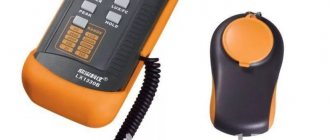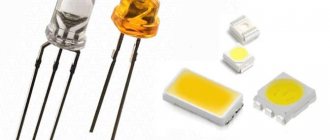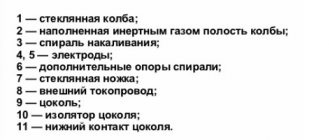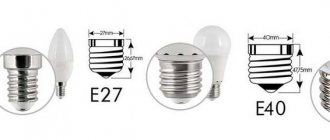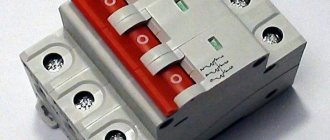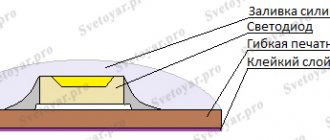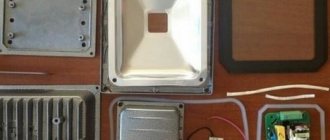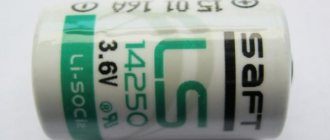Professional dosimeters
A professional radiation dosimeter is a complex device. It is known that there are three types of radioactive radiation: alpha rays, beta rays and gamma rays. In addition, there is X-ray and neutron radiation.
You may be interested in: Replenishing vocabulary: conditions are...
Professional dosimeters are capable of measuring several or all types of radiation. They also have minimal error and a large range. The data is displayed on a special display. Professional dosimeters are usually used at nuclear power plants and other enterprises dealing with nuclear energy, as well as when inspecting passengers' luggage.
The price of a professional device for measuring radiation is quite high: it often reaches 20-25 thousand rubles.
About types of radiation
Radiation reconnaissance devices allow you to examine terrain, objects, food, human skin and clothing. They allow us to identify background radiation and the degree of infection. The most harmful to humans are gamma and beta rays. Their specificity is as follows:
- Beta rays. They have an average ionizing effect. It depends on the density of the propagation medium. Their high danger is due to their significant penetrating ability. So, ordinary clothes cannot protect against them. You must have a special suit or use cover. The relatively safe standard for this type of radiation is 0.2 μSv/hour.
- Gamma rays. They pose a significant threat to optimal functioning. They have short waves, which is why a lot of destructive and penetrating energy is released. Typically, a person may not feel their effects until they receive a lethal dose.
Household dosimeters
A household dosimeter is a simplified model of a professional device. It is compact in size, convenient and easy to use. A household dosimeter, like a professional one, is capable of recording several types of radiation, but most often the package includes beta and gamma radiation sensors. This device is powered by a battery or batteries. Household dosimeters are less accurate than professional dosimeters, but they are sufficient for their intended use.
The price of this device for measuring radiation, as a rule, is not too high: on average 4900-6000 rubles.
In addition to professional and household ones, there are individual dosimeters. They are small in size and resemble a regular keychain. There is no display, the data is stored in memory and transferred to the PC when connected. The range of functions of such devices is small, but they can be useful during short-term stays in hazardous areas.
Instruments that measure radioactivity
Category: Baby food products
RADIOACTIVITY MEASURING INSTRUMENTS (from the Latin radio - emit a beam and activus - actively) are instruments designed to measure the dose of radiation or quantities associated with it. Radioactive and X-ray radiation when exposed to human sensory organs is not visible, but they can be detected using specialized instruments and devices based on physicochemical processes. The effect of radiation on humans is called exposure. The basis of this effect is the transfer of radiation energy to the cells of the body. Radiation can cause metabolic disorders, infectious complications, leukemia and malignant tumors, radiation infertility, radiation cataracts, radiation burns, and radiation sickness. All instruments for measuring ionizing and radioactive radiation are divided into three categories: radiometric (radiometers), dosimetric (dosimeters), units and devices of electronic equipment for nuclear physics research (ionization chambers, proportional counters and Geiger-Muller counters, corona and spark counters) . A radiometer is a device that can measure the activity of radiation sources and determine the flux density of ionizing light particles. It consists of a glass vessel containing an aluminum pinwheel with horizontal arms and a gas-discharge counter. Radioactivity meters (radiometers) are divided into surface pollution radiometers and air pollution radiometers. The radiometer was invented in 1873 by the English scientist W. Crookes, who proved that it could serve as a measuring instrument for various manifestations of radiation. A dosimeter (or radiometer) is a device that measures radiation doses and dose rates. It consists of three main parts: a detector, a radio circuit, and a recording (measuring) device. Dosimeters are divided into stationary, portable and individual dosimetric monitoring. It must be taken into account that during any radiation measurements there is a natural background radiation. Therefore, first, a dosimeter is used to measure the background level characteristic of a given area of the area (at a sufficient distance from the suspected radiation source), after which measurements are taken in the presence of the suspected radiation source. The presence of a stable excess above the background level may indicate the detection of radioactivity. There is nothing unusual in the fact that the dosimeter readings in an apartment are 1.5 - 2 times higher than on the street. An ionization chamber is a device that measures all types of radiation (radiation, chemical, etc.). It can be flat, cylindrical and spherical. Ionization chambers, depending on their purpose and design, can operate in both pulse and current modes. Proportional counters make it possible to determine the energy of nuclear particles and study the nature of their existence. They are filled with a gas mixture of neon and argon and operate at atmospheric pressure. A Geiger-Muller counter is a gas-discharge device that is capable of detecting and studying various types of ionizing radiation, such as alpha and beta particles, gamma rays, light and x-ray quanta, high-energy particles in cosmic rays and accelerators. The Geiger-Müller counter was created in 1908 by scientists G. Geiger and I. Müller and is based on impact ionization, that is, on the sudden action of atoms or molecules with an electrical charge in a vacuum filled with an inert gas. The Geiger-Muller counter is widely used in nuclear engineering and in the search for radioactive uranium and thorium ores. Later, in 1912, the English scientist Charles Wilson developed a laboratory device with which it was possible to both observe and record the movements of radioactive charged particles at low speeds. It was called a cloud chamber. In 1932, the Soviet physicist P. Kapitsa and the American scientist K. Anderson, based on observations of the cloud chamber, designed a more advanced device, inside of which a large electromagnet with a steel core was placed, which made it possible to more accurately determine the energy of radioactive particles. In 1959, Charles Wilson also invented a camera for recording traces of charged radioactive particles called a “magnetic spectrograph”. All devices that measure radioactivity make it possible to warn people in time about exceeding radiation levels and, possibly, prevent a disaster. Such devices currently include: dosimeters and dosimeter-radiometers MS-04B "Expert"), DG-101, "Bella", DBG-01N; ionization chambers, for example, CAT-7 and CAT-8; proportional counter SI-ZB, etc. Where to go if a high level of radiation is detected? In Moscow, you can use the following phone numbers for this: Radiation Safety Service of MosNPO Radon 379-78-31; Center for State Sanitary and Epidemiological Surveillance in Moscow, Department of Radiology 287-78-34; Operational duty officer of the Main Directorate for Civil Defense and Emergency Situations of the city of Moscow 925-34-27, 229-20-20.
Dosimeter device
The device for measuring radiation levels is quite simple. Dosimeter components:
- radiation sensor;
- removable filters;
- counting device;
- indication system.
The main component of the device is the sensor. Among them there are several types.
- Sensor based on scintillation crystals. It is universal for all types of radiation. When ionized particles pass through the crystal, photons are generated. Dosimeters with such a sensor have high measurement accuracy and are quite expensive.
- Sensors with semiconductor detector. The electrical conductivity of conductors changes when charged particles pass through the sensor. Such devices have a low price, but the measurement accuracy is usually low.
- Gas discharge sensors. The device is simple: a glass cylinder filled with gas and a wire inside the cylinder. Radioactive particles impact the gas as they pass through the cylinder, creating electricity. An example of such a sensor is a Geiger-Muller counter. Devices with such a sensor are inexpensive and suitable for detecting beta and gamma radiation.
What types of dosimeters are there?
The classification of radiometric and dosimetric monitoring devices includes several types of this type of equipment.
Depending on where radiation equipment is used and for what purposes, manufacturers of such equipment produce several separate models of products that are suitable for use both for domestic purposes and for scientific purposes. The differences between such radiation testing devices are that some devices have higher sensitivity and react to the charge level more strongly than radiometers and dosimeters that are designed for relatively low doses of radiation and can be used at home. It is worth highlighting several main types of instruments for measuring solar radiation dosimeters and the differences between them.
Order a free consultation with an ecologist
Classification of instruments for measuring radiation levels
The modern market offers many models of devices that measure radiation levels. Conventionally, they are divided into three large classes:
- radiometers that monitor the degree of activity of the emitting source and determine the flux density of α- and β-radiation on surfaces exposed to radiation;
- dosimeters that measure the amount of energy transferred to an object through radiation;
- spectrometers that analyze the emission spectrum of particles or quanta of ionizing radiation according to a certain indicator.
Each class, in turn, is divided into groups according to the type of radiation perceived: α-, β-, γ-, X-ray, neutron or their combinations. However, with a single principle of operation and a set of basic capabilities, devices that measure radiation levels are divided into two types according to their purpose:
- household - inexpensive and compact, designed to inform a person prone to radiophobia that the permissible level of radioactive radiation in a particular place has been exceeded, which allows him to quickly leave the contaminated area. However, household appliances, while assessing the level of contamination of the surrounding area, are not able to measure the dose of radiation already accumulated by a person;
- professional devices are larger and more expensive than household ones, but at the same time they have high sensitivity, a wide range and accuracy of measurements, which makes it possible to determine the real danger with greater reliability. They are used to monitor the state of the environment and control the movement of radioactive substances, and are also able to determine the dose of radioactive radiation received by a person over the entire period. Professional instruments are portable - weighing up to 1.5 kg and laboratory, designed for use in laboratory and field conditions, weighing up to 10 kg.
In non-destructive testing of materials, products, structures by radiographic methods, portable professional dosimeters, radiometers and combined radiometers-dosimeters are most often used to monitor the radiation situation.
Dosimeter
A dosimeter is a device for measuring the total dose of ionizing radiation received by a person during his stay in a radioactively contaminated area.
Based on the dosimeter readings, the severity of radiation damage received by a person during his stay in the irradiation zone is assessed. Personal dosimeters provide registration and storage of information about the radiation dose over long periods (months and years).
Depending on the design and type of dosimeter, it can measure several types of radiation or only one of its types - α, β, γ, X-ray or neutron radiation. Dosimeters capable of measuring several types of radiation have a more complex design, are quite expensive and are mainly classified as professional measuring instruments. For domestic purposes, dosimeters are usually used that measure one or two types of radiation - γ, β, and sometimes α-radiation. Household dosimeters have a smaller range of measured values and a larger measurement error, that is, household dosimeters have less accuracy.
Dosimeters can be used to measure radiation levels or act as warning indicators of radioactive hazards. According to their functional purpose, dosimeters can be divided into groups:
- indicators or signaling devices - simple devices with low sensitivity and low accuracy, which do not have a digital display, but only give a light or sound signal in case of radiation danger;
- measuring instruments are instruments for measuring background radiation, having a digital or analogue indicator that displays the level of radiation. Radiation levels can be displayed in different units, usually μSv/hour;
- search devices are highly sensitive measuring instruments with additional, usually remote (external) detectors. These devices are used to search for the slightest changes in radiation. Typically used for inspection by border guards and other intelligence agencies.
Dosimeter device
The operation of any dosimeter is based on the same operating principles. The basic element of all dosimeters is the radiation sensor. Depending on the principle of operation, radiation sensors are divided into:
- Ionization chambers are sensors whose design consists of gas-filled chambers of various designs. The operating principle is based on recording electrical disturbances that occur in the gas-discharge chamber when various charged particles pass through it. They are mainly used for recording β and γ radiation. Gas discharge sensors have a simple design and low cost. Poorly suited for recording alpha radiation.
- The most common gas-discharge sensor design is the Geiger-Muller counter , which is used in most household and professional dosimeters.
- Scintillation crystals are crystals of inorganic or organic origin. The operating principle is based on the registration of photons that are generated in the crystal if charged particles (electrons, protons, neutrons, α-particles) pass through it. Can be used to register all types of radiation. They are mainly used in search instruments, as they have high sensitivity and accuracy. They are quite large in size and high in cost.
- Solid State Semiconductor Detectors – Consist of crystals and semiconductor material. The operating principle is based on a change in the electrical conductivity of the material when charged particles (electrons, protons, neutrons) pass through it. Can be used to register all types of radiation. They have low accuracy, but at the same time they are small in size and low in cost.
Source: Civil Defense: Encyclopedia in 4 volumes. Volume I (A–I); under the general editorship of S.K. Shoigu; Russian Emergency Situations Ministry. – M.: Moscow Printing House No. 2, 2006.
DOSIMETRIC DEVICES
The principle of detecting ionizing (radioactive) radiation (neutrons, gamma rays, beta and alpha particles) is based on the ability of these radiations to ionize the substance of the environment in which they propagate. Ionization, in turn, causes physical and chemical changes in a substance that can be detected and measured. Such changes in the environment include: changes in the electrical conductivity of substances (gases, liquids, solids); luminescence (glow) of certain substances; exposure of photographic films; change in color, color, transparency, resistance to electric current of some chemical solutions, etc.
The following methods are used to detect and measure ionizing radiation: photographic, scintillation, chemical and ionization
The photographic method is based on the degree of blackening of the photographic emulsion. Under the influence of ionizing radiation, the molecules of silver bromide contained in the photographic emulsion disintegrate into silver and bromine. In this case, tiny silver crystals are formed, which cause blackening of the photographic film when it is developed. The density of blackening is proportional to the absorbed radiation energy. By comparing the blackening density with the standard, the radiation dose (exposure or absorbed) received by the film is determined. Individual photodosimeters are based on this principle.
Scintillation method. Some substances (zinc sulfide, sodium iodide) glow under the influence of ionizing radiation. The number of flashes is proportional to the radiation dose rate and is recorded using special devices - photomultipliers
Chemical method. Some chemicals change their structure when exposed to ionizing radiation. Thus, chloroform in water decomposes upon irradiation to form hydrochloric acid, which gives a color reaction with a dye added to chloroform. Bivalent iron in an acidic environment is oxidized into trivalent iron under the influence of free radicals HO 2 and OH, formed in water during its irradiation. Ferric iron with a dye gives a color reaction. The density of the color is used to judge the dose of radiation (absorbed energy). Chemical dosimeters DP-70 and DP-70M are based on this principle
In modern dosimetric instruments, the ionization method of detecting and measuring ionizing radiation has become widespread.
Ionization method.
Under the influence of radiation in an isolated volume, gas ionization occurs: electrically neutral atoms (molecules) of the gas are divided into positive and negative ions. If two electrodes are placed in this volume, to which a constant voltage is applied, an electric field is created between the electrodes. In the presence of an electric field in an ionized gas, a directed movement of charged particles occurs, i.e. An electric current called ionization current passes through the gas. By measuring the ionization current, one can judge the intensity of ionizing radiation
Devices operating on the basis of the ionization method have a fundamentally identical device and include: a receiving device (ionization chamber or gas-discharge counter) 1, an ionization current amplifier (an electrical circuit including an electrometric lamp 2, a load resistance 3 and other elements), a recording device 4 ( microammeter) and power source 5 (dry cells or batteries).
The ionization chamber is a closed volume filled with air, inside of which there are two electrodes isolated from each other (like a capacitor). Voltage from a direct current source is applied to the chamber electrodes. In the absence of ionizing radiation, there will be no current in the circuit of the ionization chamber, since air is an insulator. When exposed to radiation in the ionization chamber, air molecules are ionized. In an electric field, positively charged particles move towards the cathode, and negatively charged particles move towards the anode. An ionization current occurs in the chamber circuit, which is recorded by a microammeter. The numerical value of the ionization current is proportional to the radiation power. Consequently, the ionization current can be used to judge the dose rate of radiation affecting the chamber. The ionization chamber operates in the saturation region
A gas-discharge counter is used to measure low-intensity radioactive radiation. The high sensitivity of the counter makes it possible to measure radiation intensity tens of thousands of times less than what can be measured by an ionization chamber
A gas-discharge counter is a hollow, sealed metal or glass cylinder filled with a discharged mixture of inert gases (argon, neon) with some additives that improve the performance of the counter (alcohol vapor). Inside the cylinder, along its axis, there is a thin metal thread (anode), isolated from the cylinder. The cathode is a metal body or a thin layer of metal deposited on the inner surface of the glass body of the meter. An electric voltage is applied to the metal thread and the conductive layer (cathode)
Gas discharge meters use the principle of gas discharge amplification. In the absence of radioactive radiation, there are no free ions in the volume of the counter. Therefore, there is also no electric current meter in the circuit. When exposed to radioactive radiation, charged particles are formed in the working volume of the counter. Electrons, moving in an electric field to the anode of the counter, the area of which is much smaller than the area of the cathode, acquire kinetic energy sufficient for additional ionization of atoms of the gaseous medium. The electrons knocked out in this process also produce ionization. Thus, one particle of radioactive radiation entering the volume of the gas meter mixture causes the formation of an avalanche of free electrons. A large number of electrons are collected on the counter filament. As a result, the positive potential decreases sharply and an electrical impulse occurs. By recording the number of current pulses occurring per unit time, one can judge the intensity of radioactive radiation
Dosimetric devices are intended for:
exposure control - obtaining data on absorbed or exposure doses of radiation by people and farm animals;
control of radioactive contamination by radioactive substances of people, farm animals, as well as machinery, transport, equipment, personal protective equipment, clothing, food, water, fodder and other objects;
radiation reconnaissance - determining the level of radiation on the ground
In addition, with the help of dosimetric instruments, the induced radioactivity of various technical means, objects and soil irradiated by neutron fluxes can be determined. For radiation reconnaissance and dosimetric monitoring at the facility, dosimeters and exposure dose rate meters are used, the tactical and technical characteristics of which are given in Table No. 1
Sets of individual dosimeters DP-22V and DP-24,
having pocket dosimeters directly showing DKP-50A, designed to control exposure doses of gamma radiation received by people when working in areas contaminated with radioactive substances or when working with open and closed sources of ionizing radiation
The set of dosimeters DP-22V (Fig. No. 1, a) consists of a charger of 1 type ZD-5 and 50 individual pocket dosimeters directly showing 2 types of DKP-50A. Unlike DP-22V, the DP-24 dosimeter set (Fig. No. 1, b) has five DKP-50A dosimeters
Charger 1
Designed for charging DKP-50A dosimeters. The ZD-5 housing contains: a voltage converter, a high-voltage rectifier, a potentiometer-voltage regulator, a light bulb for illuminating the charging socket, a microswitch and batteries. On the top panel of the device there are: potentiometer handle 3, charging socket 5 with cap 6 and power compartment cover 4. Power is supplied from two dry cells of type 1.6-ПМЦ-У-8, ensuring continuous operation of the device for at least 30 hours at a current consumption of 200 mA . The voltage at the charger output is smoothly adjustable from 180 to 250V
Control dosimeter
direct indicating DKP-50A is designed for measuring exposure doses of gamma radiation. Structurally, it is made in the shape of a fountain pen (Fig. No. 2). The dosimeter consists of a duralumin body 1, in which an ionization chamber and a capacitor, an electroscope, a reading device and a charging part are located
The main part of the dosimeter is a small-sized ionization chamber 2, to which a capacitor 4 with an electroscope is connected. The external electrode of the camera-capacitor system is a duralumin cylindrical body 1, the internal electrode is an aluminum rod 5. The electroscope is formed by the curved part of the internal electrode (holder) and a platinized reticle (moving element) glued to it 3
Table No. 1
Name | Purpose | measurement range | Measured dose error, % | Operating temperature range, ° C | Basic data on completeness | Measured dose error, % |
| Dosimeters | ||||||
| Set of dosimeters DP-22V, having DKP-50A | To measure exposure doses of gamma radiation | 2-50R | ± 10 | -40…+50 | DKP-50A-50 pcs. Charger ZD-5 – 1 piece | Dkp-50A - 32 g. Set in a storage box - 5 kg; ZD-5 - 1.4 kg |
| Set of dosimeters DP-24, having DKP-50A | Same | 2-50R | ± 10 | -40…+50 | DKP-50A-5 pcs. Charger ZD-5 – 1 piece | Set in a storage box - 3.2 kg; |
| Set of individual dosimeters ID-1 | To measure absorbed doses of gamma neutron radiation | 20-500rad | ± 20 | -50…+50 | ID-1 - 10 pcs. Charger ZD-6 - 1 piece | ID-1 -40 g Set in a case - 1.5 kg. ZD-6 - 0.5kg |
| Exposure dose rate meters (radiometers-roentgenometers) | ||||||
| Dose rate meter DP-5A (B) | To measure the exposure dose rate of gamma radiation on the ground and radioactive contamination of various surfaces by gamma radiation | 0.05mR/h – 200R/h | ± 30 | -40…+50 at humidity 65 ± 15% | Device in a case with a control source of beta radiation - 1 pc. Extension rod - 1 pc. | 2,8 |
| Dose rate meter DP-5V | Same | 0.05mR/h – 200R/h | ± 30 | -40…+50 at humidity 65 ± 15% | Same | 3,2 |
| Onboard power meter DP-3B | To measure the exposure dose of gamma radiation on the ground | 0.1-500R/h | ± 10 (±15 on the first sub-band) | -40…+50 | Measuring remote control - 1 piece. Remote block - 1 pc. Spare parts-1 set | 4,4 |
In the front part of the body there is a reading device - a microscope with 90x magnification, consisting of an eyepiece 9, a lens 12 and a scale 10. The scale has 25 divisions (from 0 to 50). The price of one division corresponds to two roentgens. The scale and eyepiece are secured with a shaped nut
At the rear of the case there is a charging part, consisting of a diaphragm 7 with a movable contact pin 6. When pressed, pin 6 closes with the internal electrode of the ionization chamber. When the load is removed, the contact pin is returned to its original position by the diaphragm. The charging part of the dosimeter is protected from contamination by a protective frame 8. The dosimeter is attached to a clothing pocket using a holder 11
Operating principle of the dosimeter
similar to the action of a simple electroscope. During the charging of the dosimeter, the sighting line 3 of the electroscope deviates from the internal electrode 5 under the influence of electrostatic repulsion forces. The deflection of the thread depends on the applied voltage, which, during charging, is regulated and selected so that the image of the target thread aligns with the zero of the scale of the reading device
When a charged dosimeter is exposed to gamma radiation, an ionization current occurs in the working volume of the chamber. The ionization current reduces the initial charge of the capacitor and chamber, and therefore the potential of the internal electrode. The change in potential measured by an electroscope is proportional to the exposure dose of gamma radiation. Changing the potential of the internal electrode leads to a decrease in the electrostatic repulsion forces between the reticle and the electroscope holder. As a result, the reticle moves closer to the holder, and its image moves along the scale of the reading device. By holding the dosimeter against the light and observing the filament through the eyepiece, you can count the resulting exposure dose of radiation at any time.
The DKP-50A dosimeter provides measurement of individual exposure doses of gamma radiation in the range from 2 to 50 R at radiation exposure dose rates from 0.5 to 200 R / h. The self-discharge of the dosimeter under normal conditions does not exceed two divisions per day
The DKP-50A dosimeter is charged before going to work in an area of radioactive contamination (exposure to gamma radiation) in the following order:
unscrew the protective frame of the dosimeter (stopper with glass) and the protective cap of the ZD-5 charging socket;
turn the charger potentiometer knob to the left all the way;
insert the dosimeter into the charging socket of the charger, the charging socket illumination and high voltage turn on;
looking through the eyepiece, lightly press the dosimeter and, turning the potentiometer knob to the right, set the thread to “0” of the scale, then remove the dosimeter from the charging socket;
check the position of the thread against the light: its image should be on o, screw up the protective frame of the dosimeter and the cap of the charging socket
The exposure dose of radiation is determined by the position of the thread on the scale of the reading device. The reading must be made with the thread in a vertical position in order to exclude the influence of thread deflection from weight on the dosimeter reading
ID-1 kit
is intended for measuring absorbed doses of gamma-neutron radiation. It consists of individual dosimeters ID-1 and charger ZD-6. The operating principle of the ID-1 dosimeter is similar to the operating principle of dosimeters for measuring exposure doses of gamma radiation (for example, DKP-50A)
Dose rate meters
DP-5A and DP-5V are designed to measure radiation levels in the area and radioactive contamination of various objects by gamma radiation. The power of gamma radiation is determined in milliroentgens or roentgens per hour for the point in space at which the corresponding counter of the device is placed during measurements. In addition, it is possible to detect beta radiation
The gamma radiation measurement range is from 0.05 mR/h to 200 R/h in the gamma quanta energy range from 0.084 to 1.25 MeV. Devices DP-5A, DP-5B and DP-5V have six measurement subranges (Table No. 2). The instrument readings are read on the lower scale of the microammeter in R/h, on the upper scale - mR/h, followed by multiplication by the corresponding sub-range coefficient. Sections of the scale from zero to the first significant digit are inoperative
Tables No. 2
| Subbands | Subband switch knob position | Scale | Unit | Measurement limits | Time to establish indicators, s |
| I | 200 | 0-200 | R/h | 5-200 | 10 |
| II | X1000 | 0-5 | mR/h | 500-5000 | 10 |
| III | X100 | 0-5 | Same | 50-500 | 30 |
| IV | X10 | 0-5 | » | 5-50 | 45 |
| V | X1 | 0-5 | » | 0,5-5 | 45 |
| VI | X0 ,1 | 0-5 | » | 0,05-0,5 | 45 |
The devices have sound indication on all subbands except the first. Sound indication is listened to using headphones 8 (Fig. No. 3)
The devices are powered by three dry elements of the KB-1 type (one of them is for illuminating the scale), which ensure continuous operation under normal conditions for at least 40 hours - DP-5A and 55 hours - DP-5V. The devices can be connected to external DC sources with a voltage of 3.6 and 12V - DP-5A and 12 or 24V - DP-5V, having for this purpose a power supply and a voltage divider with a cable 10 m long, respectively.
Construction of DP-5A (B) and DP-5V devices. The device kit includes: case with straps; extension rod; power supply block to DP-5A (B) and voltage divider to DP-5V; a set of operational documentation and spare equipment; telephone and storage box
The device consists (see Fig. No. 3) of a measuring panel; probe in DP-5A (B) or detection unit in DP-5V 1, connected to the remote control with flexible cables 2; control strontium-yttrium source of beta radiation to check the performance of devices (on the inside of the case cover for DP-5A (B) 9 and on the detection unit for DP-5V)
Measuring console
consists of a panel and a casing. The measuring panel panel contains: a microammeter with two measuring scales 3; subband switch 4; “Mode” knob 6 (mode adjustment potentiometer); reset button (“Reset”) 7; scale backlight toggle switch 5; zero adjustment screw 10; telephone socket 11. The panel is attached to the casing with two captive screws. The elements of the device circuit are mounted on a chassis connected to the panel using a hinge and a screw. At the bottom of the casing there is a compartment for placing power supplies. In the absence of batteries, a voltage divider from DC sources can be connected here
The sensing devices of the devices are gas-discharge counters installed: in the DP-5A device - one (SIZBG) in the measuring console and two (SIZBG and STS-5) in the probe; in the DP-5V device - two (SBM-20 and SIZBG) in the detection unit
Probe and detection unit 1
It is a steel cylindrical case with a window for indicating beta radiation, sealed with ethylcellulose waterproof film, through which beta particles penetrate. A metal rotating screen is placed on the body, which is fixed in two positions (“G” and “B”) on the probe and in three positions (“G”, “B” and “K”) on the detection unit. In the “G” position, the housing window is covered with a screen and only gamma rays can penetrate into the counter. When the screen is rotated to position “B,” the housing window opens and beta particles penetrate to the counter. In the “K” position, the control source of beta radiation, which is mounted in a recess on the screen, is installed against the window and in this position the functionality of the DP-5V device is checked
The bodies of the probe and the detection unit each have two protrusions, with the help of which they are installed on the surfaces being examined to indicate beta contamination. Inside the case there is a board on which gas-discharge counters, an amplifier-normalizer and an electrical circuit are mounted
Device case
consists of: DP-5A – of two compartments (for installing the remote control and probe); DP-5V – of three compartments (to accommodate the remote control, detection unit and spare batteries). The cover of the case has windows for observing the instrument readings. To carry the device, two straps are attached to the case.
Phone 8
consists of two small-sized phones of the TG-7M type and a headband made of soft material. It connects to the measuring console and detects the presence of radioactive radiation: the higher the radiation power, the more frequent the sound clicks
Spare parts included with the device include covers for the probe, caps, incandescent bulbs, a screwdriver, and screws.
Preparing the device for operation
carried out in the following order:
remove the device from the storage box, open the cover of the case, carry out an external inspection, fasten the waist and shoulder belts to the case;
remove the probe or detection unit; attach a handle to the probe, and a rod (used as a handle) to the detection unit;
use a corrector to set a mechanical zero on the microammeter scale;
connect power supplies;
turn on the device by placing the subrange switch knobs in the position: “Mode.” DP-5A and “t” (mode control) DP-5V (the instrument needle should be set in the regime sector); in DP-5A, use the potentiometer knob to set the device arrow in the regime sector to “u”. If the microammeter needles do not enter the operating sectors, it is necessary to replace the power supplies
The performance of the devices is checked on all subbands, except the first (“200”), using control sources, for which the screens of the probe and the detection unit are installed in positions “B” and “K”, respectively, and telephones are connected. In the DP-5A device, open the control beta source, install the probe with its supporting protrusions on the cover of the case so that the source is located opposite the open window of the probe. Then, sequentially moving the subrange switch to the positions “*1000”, “*100”, “*10”, “*1”, “*0.1”, observe the readings of the device and listen to clicks in the phones. The microammeter needles should go off scale in the VI and V subranges, deviate in the IV, and in III and II they may not deviate due to insufficient activity of the control beta sources
After this, set the switch knobs to the “Off” position. DP-5A and “t” – DP-5V; press the “Reset” buttons; turn the screens to the “G” position. Devices are ready for use
Radiation reconnaissance of the area,
with radiation levels from 0.5 to 5 R/h, are produced in the second sub-range (the probe and detection unit with the screen in the “G” position remain in the instrument casings), and above 5 R/h - in the first sub-range. When measuring, the device should be at a height of 0.7–1 m from the ground surface
Degree of radioactive contamination
the skin of people, their clothing, farm animals, machinery, equipment, transport, etc. determined in this order. The gamma background is measured in the place where the degree of infection of the object will be determined, but not less than 15-20 m from the object being examined
To determine the presence of induced activity
of equipment exposed to neutron radiation, two measurements are made - outside and inside the equipment. If the measurement results are close to each other, this means that the equipment has induced activity
To detect beta radiation
it is necessary to set the probe screen to position “B”, bring it to the surface being examined at a distance of 1.5-2 cm. turn the subrange switch knob sequentially to the positions “* 0.1”, “*1”, “*10” until the microammeter needle deflects within the scale. An increase in instrument readings in the same sub-band compared to a gamma measurement indicates the presence of beta radiation
If you need to find out on which side the surface of tarpaulin awnings, walls and partitions of buildings and other objects transparent to gamma radiation is contaminated, then take two measurements in the probe position “B” and “D”. the surface is contaminated on the side from which the device readings in probe position “B” are noticeably higher
When determining the degree of radioactive contamination of water
take two samples with a total volume of 1.5-10 liters. One is from the upper layer of the water source, the other is from the bottom layer. Measurements are made with a probe in position “B”, placing it at a distance of 0.5-1 cm from the surface of the water, and readings are taken on the upper scale
The nameplates on the case covers provide information about the permissible standards of radioactive contamination and indicate the subranges at which they are measured
Onboard dose rate meter DP-3B
(Fig. No. 4) is designed to determine radiation levels in areas contaminated with radioactive substances. It can be installed on cars, airplanes, helicopters, river boats, diesel locomotives, as well as in shelters and anti-radiation shelters. The device is powered from DC sources with voltage of 12 or 26V
The device kit includes
: measuring console A, remote unit B, power cable with straight connector 1, cable with angled connector 9 for connecting the console with remote unit B, mounting brackets, technical documentation and accessories. The panel of the measuring panel contains: a microammeter with a two-row scale 3 (the division price of the upper scale is 0.05 R/h, the lower one is 50 R/h), light indication lamp 6, backlight lamp 4 of the microammeter scale and subrange indicator 5, fuses 8, button “ Check” 2, sub-range switch 7 into six positions: off “Off”, on “On”, “*1”, “*10”, “*100” and “500”
Preparing the device for operation DP-3B for operation: checking the kit, external inspection of the device and accessories, assembling the device, connecting to the power circuit, checking functionality.
The functionality of the device is checked in the “On” switch position. By clicking the "Check" button. In this case, the microammeter needle should be in the range of 0.4-0.8 R/h, and the indicator lamp should give frequent flashes or burn continuously
Before measuring radiation levels
set the switch to the “On” position And wait until the microammeter needle settles within the blackened area of the scale. Then set the switch to the position of the first sub-range (“*1”) and after 30 s, read the readings on the upper scale of the microammeter. If the arrow goes off scale, set the switch sequentially to the position of the second, third and fourth subranges. Readings on the first three subranges are taken on the upper scale and multiplied by factors of 1, 10, 100, respectively. On the fourth subrange, readings are taken on the lower scale without multiplying by any coefficient
